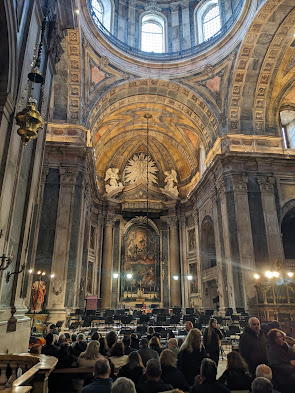The Good and Bad of Holiday Concerts
Portugal's classical scene feature many typical holiday concerts, including those with too-familiar repertory (eg Sleighride, Nutcracker). Compared to the USA there are fewer Messiahs, but more Bach Christmas Oratorios, as in most of Europe. Last weekend I saw two very non-typical holiday concerts that should have made a nice pair. The Austrian organist-composer Anton Bruckner (1824-1896) started neurotically laboring over his 10 published massive symphonies late in life (mostly after age 50) and was heavily influenced by his contemporaries Brahms and Wagner. In many ways his symphonies synthesize the music of both. So I looked forward to hearing two concerts the same day featuring these three composers.
First, the good. The Orquestra Metropolitana de Lisboa (OML) performed a free concert of the Bruckner Symphony No. 7 in E major in the gorgeous Basílica da Estrela (see below). It was exciting to see a Bruckner concert with people lined up outside in the rain one hour in advance to get in, since Bruckner is hardly the most flashy or popular composer, and because this symphony lasts > 75 minutes, so is not the easiest of family fare. Inside, many people were standing and sitting on the hard stone aisles (were fire codes met?), and the audience included many children, which you would definitely not see in the USA. We all heard a great concert. The guest conductor Michael Zilm had firm control over the (sometimes too-) sprawling piece, and coaxed the massive orchestra into some exciting climaxes, thrilling in the cathedral space. Cathedrals are not always conducive to great music, as the reverberation time can swallow detail, but here Zilm achieved remarkable clarity. When Bruckner did some of his famous pauses after a grand buildup, Zilm allowed for plenty of time for the sound to decay (it needed > 5 seconds) before resuming. Tempos were slightly slow, appropriate for this space, but never sounded sluggish, often a problem in Bruckner performances. You really heard how Bruckner was able to take his long experience as an organist and translate some of this sound to a full symphony orchestra, now playing in an acoustic that an organist would have loved.
The orchestra sounded great, and I was particularly impressed by the titanic crescendo buildups of the first movement, ending in an ultimate, enormous organ-like climax by the massed brasses (6 horns, three trumpets, three trombones, tuba, and four Wagner tubas. The latter instruments, which are similar to euphoniums (small tubas), are assigned many wonderful chordal ensemble passages in this piece, and were standout players here. The family audience was stunningly well behaved, and did not clap between the long movements, with only a single unfiltered member bellowing "bravissimo" after the long second movement, somewhat ruining the ambiance. This was yet another outstanding performance for an orchestra that is fast becoming my favorite Portuguese ensemble. How many free Bruckner concerts have you seen?
The Wagner/Brahms concert by the Orquestra de Câmara de Cascais e Oeiras (OCCO) was another thing entirely. This fine chamber group, renamed here as the Orquestra Sinfónica de Cascais, was unsuccessful in expanding to a large-sized romantic ensemble for this concert, The first violin sound was consistently grating and unpleasant, never a problem before when I head the OCCO. Equally concerning was that the concert sounded underprepared. The insecurity of playing was distressing, eg a loud wrong entrance by a violist on the Tannhauser overture, hesitant and inaccurate playing by the oboes and horns on the Brahms Haydn Variations, and a general lack of ensemble accuracy in the Brahms Symphony No. 3. This most mellow of the Brahms symphonies was particularly harmed by the unrefined violin sound. I was a bit shocked at the low quality of this performance...not something I have previously heard from Portuguese professional ensembles. I guess that every so often hearing a bad performance helps you remember the difficulty and exactitude that goes into preparing these great works for performance, and also how easy it can be for things to fall apart when either rehearsals, personnel, or the stars are not in good alignment.

Comments
Post a Comment